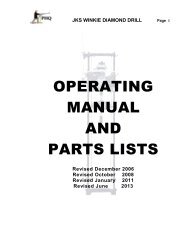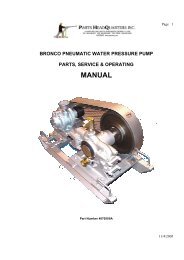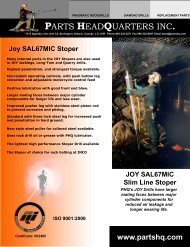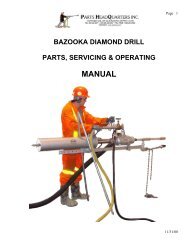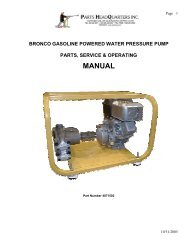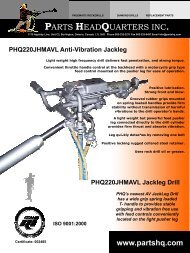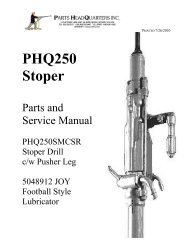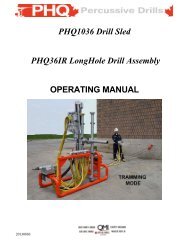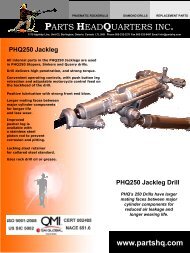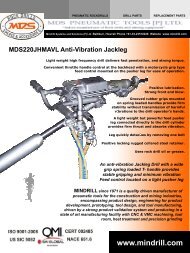PHQ250JHMAVL Jackleg MK 1 Parts and Repair Manual PDF
PHQ250JHMAVL Jackleg MK 1 Parts and Repair Manual PDF
PHQ250JHMAVL Jackleg MK 1 Parts and Repair Manual PDF
You also want an ePaper? Increase the reach of your titles
YUMPU automatically turns print PDFs into web optimized ePapers that Google loves.
Troubleshooting Guides<br />
Problem Probable Cause Remedy<br />
Page 40<br />
______________________________________________________________________________<br />
112. Pusher Leg not<br />
functioning properly.<br />
Check the Clevis body for<br />
loose fitting or damage (SM 1)<br />
Drill is jumping on the<br />
leg during drilling<br />
operations.<br />
Insufficient (lack of volume) or<br />
erratic pressure supply of air to the<br />
pusher leg.<br />
Leg control h<strong>and</strong>le assembly<br />
O-Rings worn out (SM 18).<br />
Retract valve O-Rings worn<br />
out or damaged (SM 7)<br />
Replace parts in rockdrill shop<br />
Bucket seals in leg worn<br />
Bent piston rod<br />
Dented pusher leg cylinder<br />
Examine <strong>and</strong> replace bucket<br />
seals (See Leg <strong>Manual</strong>)<br />
Check piston rod. Return to<br />
rockdrill shop. Replace if bent.<br />
Check the cylinder for dents<br />
<strong>and</strong> return to rockdrill shop for<br />
replacement if dented.<br />
______________________________________________________________________________<br />
Drill steel was worn or chipped to Remove damaged steel from<br />
begin with.<br />
the circuit. Check piston face.<br />
113. Drill steel failing at<br />
the collar or forming a<br />
coke bottle shape.<br />
Drill steel showing chips<br />
or chunks out of striking<br />
face at the collar end.<br />
Pistons in drills have<br />
chips out of the striking<br />
face or are failing at the<br />
striking face.<br />
Experience has proven:<br />
“One chipped piston can<br />
damage a lot of new drill<br />
rods. One chipped drill<br />
rod can damage a lot of<br />
new pistons”!<br />
They need to be removed<br />
Piston in the drill has a chipped or<br />
broken front striking face.<br />
Drill steel does not have a square<br />
face on the striking end.<br />
Refaced piston in the drill was not<br />
machined properly.<br />
Worn chuck insert<br />
Worn chuck parts caused by poor<br />
alignment of steel with the hole<br />
Collaring holes with drill steel<br />
longer than four feet.<br />
Running out the full length of the<br />
leg so that the lack of push makes<br />
the drill bounce on the drill rod<br />
Replace the piston. Check<br />
drill steel for chipped ends.<br />
Remove damaged steel from<br />
the circuit. Check piston face.<br />
Replace the piston in the rock<br />
drill shop. (SM 59-60)<br />
Check the chuck insert with<br />
gauge. If worn replace in the<br />
rock drill shop. (SM 44)<br />
Replace the worn parts Check<br />
the drill steel ends are square.<br />
Holes should be collared with<br />
two foot or four foot drill rods.<br />
Side pressure enlarges chuck<br />
inserts or breaks the insert.<br />
Always pull in the leg before<br />
reaching full extension <strong>and</strong><br />
reposition to continue drilling.<br />
______________________________________________________________________________<br />
Version 200711



